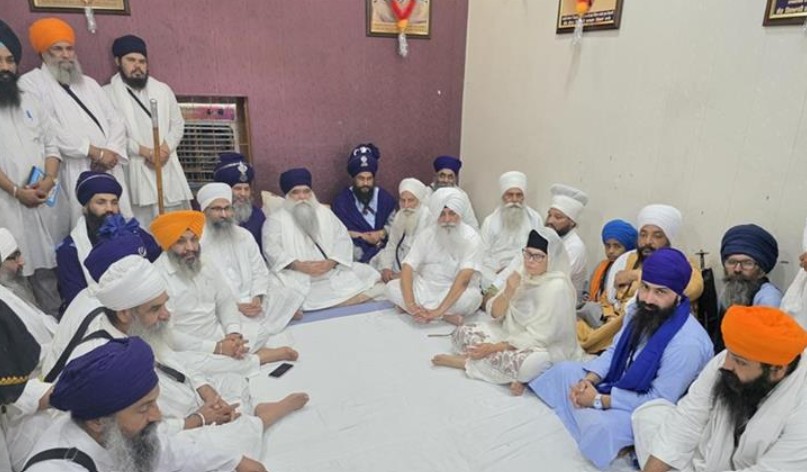The Damdami Taksal, one of the most influential and historical Sikh religious organizations, has made a significant announcement that has stirred attention across Punjab. In a move rooted in religious and social sentiment, the Taksal declared that 500 Sikhs will organize a peaceful sit-in protest at Badal village on June 11. This announcement has ignited conversations in political, religious, and civil society circles, given the symbolism attached to both the organization and the location.
Damdami Taksal, with its deep roots tracing back to the time of Guru Gobind Singh, has traditionally played a vital role in Sikh religious education and moral leadership. Over the decades, it has been at the forefront of several significant socio-religious movements. The recent announcement to hold a dharna (sit-in) is being seen not just as a form of protest but as a statement of collective Sikh consciousness aiming to voice concerns that they believe need urgent attention.
Badal village, the ancestral home of the Badal family, carries great political symbolism. Former Chief Minister Parkash Singh Badal, a towering figure in Punjab politics and in the Shiromani Akali Dal, hailed from this village. Choosing Badal as the site of the sit-in is a deliberate and powerful decision, hinting at possible dissatisfaction with political leadership, historical grievances, or ongoing tensions regarding the handling of Sikh religious, political, and social issues.
According to the official statement issued by the Damdami Taksal leadership, the sit-in will be peaceful, disciplined, and conducted in accordance with Sikh principles of protest — with prayer, kirtan, and ardas (supplication) playing an important role. The objective, they stated, is not to create unrest but to draw attention to longstanding issues that have been ignored or mishandled by political figures who, in the eyes of the organizers, failed to uphold Sikh values and aspirations.

Preparations for the sit-in have already begun. Various units of the Damdami Taksal have started mobilizing members, and training sessions are being held to ensure that the protest remains orderly and dignified. In several Gurdwaras across Punjab, announcements are being made after prayers to encourage participation and to mentally prepare the volunteers for the spiritual and physical discipline needed for such a protest. Participants are being instructed to carry the Guru’s message of peace and justice and to avoid any actions that could be misinterpreted as confrontational.
The political implications of this event are hard to miss. Observers note that this sit-in could be seen as a form of public accountability, with religious institutions stepping into a space where political processes have not adequately addressed communal concerns. There is also the possibility that this move could reignite debates about the role of religious bodies in political matters in Punjab — a recurring theme in the state’s post-independence history.
Furthermore, this announcement comes at a time when Punjab is grappling with multiple challenges: drug addiction, farmer distress, environmental degradation, and a perceived erosion of cultural and religious values among the youth. Many in the Sikh community feel that political leadership, across parties and generations, has failed to safeguard Punjab’s unique identity and welfare. The Damdami Taksal’s move can thus also be interpreted as an expression of a broader desire for introspection and course correction within the community.
Senior leaders of the Taksal have emphasized that the protest will focus on moral rejuvenation rather than partisan politics. They have categorically stated that their purpose is not to support or oppose any political party but to remind the Sikh and Punjabi leadership at large about their responsibilities to the people. They have urged Sikhs from all walks of life — irrespective of political affiliation — to see the sit-in as a call to action for the betterment of Punjab’s future.
Security arrangements are likely to be a major concern given the sensitivities involved. The Punjab Police and local administration are reportedly making preparations to ensure that the event passes off peacefully. There are plans to deploy adequate security personnel to prevent any untoward incidents and to facilitate the smooth conduct of the sit-in. Coordination meetings between organizers and district authorities are expected to be held in the days leading up to June 11.
Public opinion on the upcoming protest is divided but engaged. Many ordinary citizens see it as a necessary reminder to the political class that they are answerable to the people and to the ideals that have historically defined Punjab. Others are cautious, fearing that any misstep could be exploited by elements seeking to disturb the peace. Social media platforms have been abuzz with discussions, and there is a palpable sense of anticipation about how the sit-in will unfold and what it might ultimately achieve.
Religious scholars and community leaders have also weighed in, stressing that the spirit of Sikhism advocates standing up against injustice through peaceful means. They have expressed hope that the sit-in would inspire a broader movement for the revival of Sikh principles of service, humility, and righteous action in public life. Many are seeing June 11 as a day of reckoning, a day when Punjab will be called upon to reflect on its past mistakes and commit to a better future.
In the coming days, more details are expected to emerge about the schedule of events during the sit-in, the speeches to be delivered, and the key demands that the Taksal will articulate. It is clear, however, that the Damdami Taksal’s announcement has already succeeded in focusing public attention on urgent issues that need to be addressed, not just by political leaders but by society at large.
In conclusion, the Damdami Taksal’s decision to organize a peaceful sit-in at Badal village on June 11 marks an important moment in contemporary Punjab’s socio-political landscape. It is a call for introspection, responsibility, and the reaffirmation of core Sikh values. Whether this protest will lead to tangible changes or remain a symbolic gesture will depend largely on how all stakeholders — political, religious, and civil — respond to the message being conveyed. What is certain, however, is that the spirit behind the sit-in is deeply rooted in the ethos of standing up for truth and justice — principles that have always guided the Sikh community through history.


